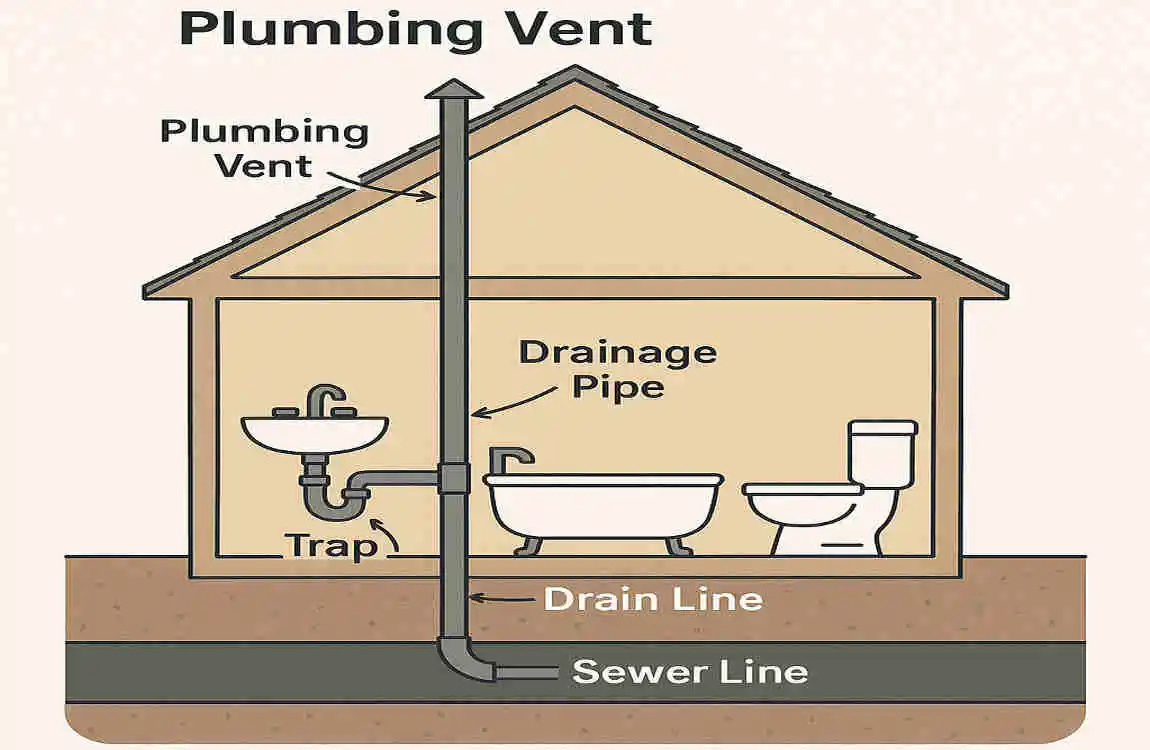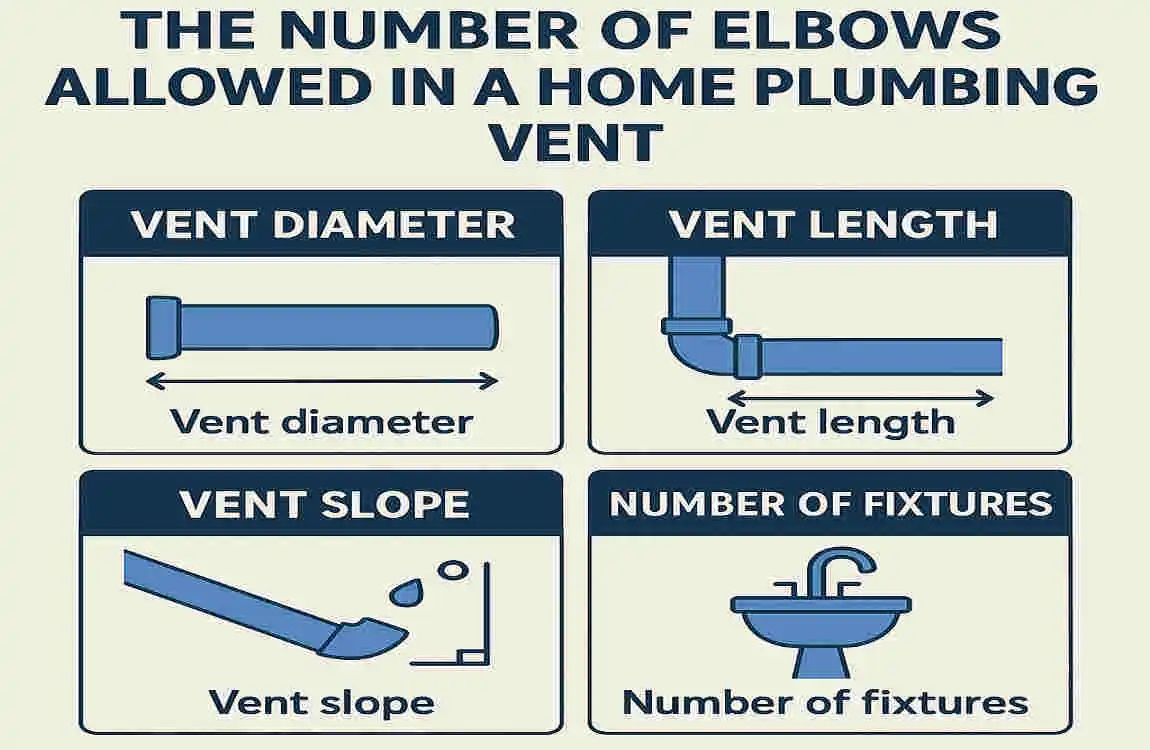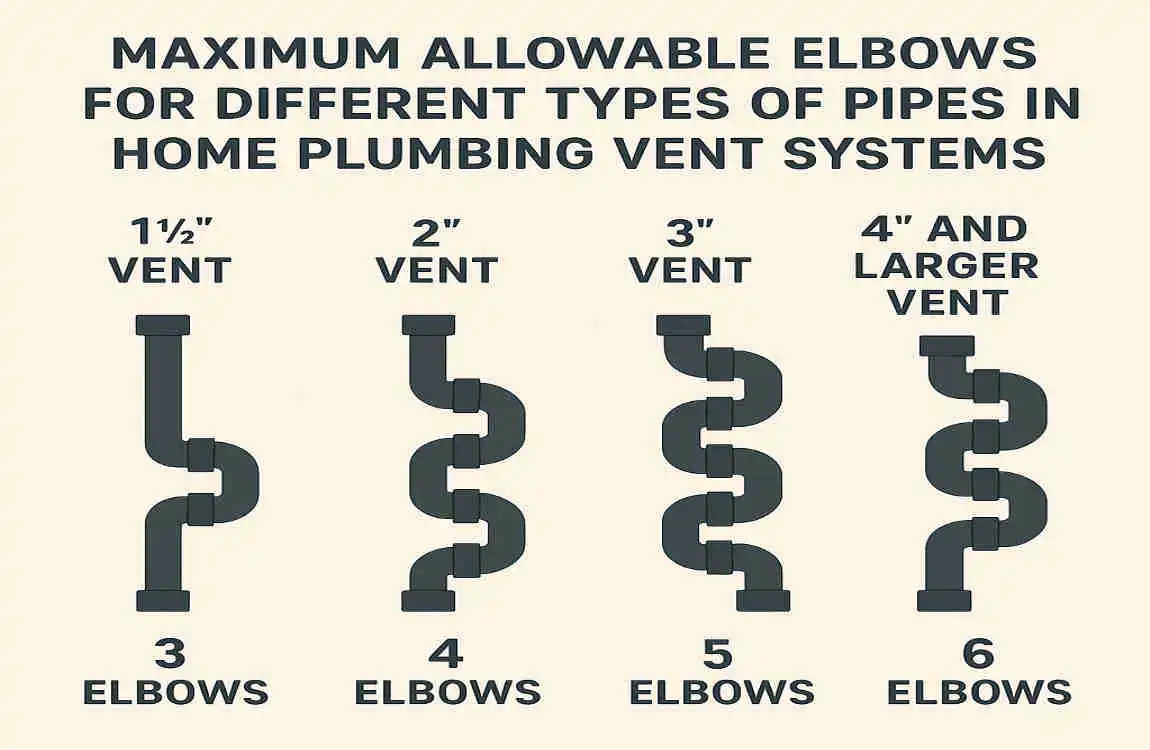A home plumbing vent typically can have a maximum of two 90-degree elbows to ensure proper airflow and optimal function. Excessive elbows or sharp turns can restrict air movement, leading to venting issues and reduced home plumbing performance. However, specifics may vary depending on local codes and special conditions, so it is recommended to check local regulations for compliance.
Understanding the Purpose of a Home Plumbing Vent

A home plumbing vent serves a vital purpose in ensuring your plumbing system functions smoothly. It acts as a pathway for air, allowing equal pressure to be maintained in the pipes. This balance is crucial for efficient drainage, allowing waste to flow freely.
Without proper ventilation, you might encounter slow drains and unpleasant odours wafting back into your living spaces. The vent mitigates these issues by preventing vacuum formation, which can trap water in traps and lead to clogs.
Understanding how these vents operate enables homeowners to appreciate their importance more profoundly. It’s not just about moving waste; it’s about creating an ecosystem where everything works harmoniously together.
The Importance of Proper Venting in a Plumbing System

Proper venting is essential for any plumbing system. It allows air to enter the pipes, which helps waste move smoothly through the drainage system. Without adequate ventilation, you might experience slow drains and unpleasant odours.
When vents are functioning correctly, they prevent pressure buildup. This balance ensures wastewater flows continuously without interruption. If there’s a blockage or malfunction in the venting system, it can lead to serious issues like backups or even structural damage.
It’s essential not only for efficiency but also for health and safety reasons. Ensuring that your plumbing has an effective venting strategy will make all the difference in performance over time.
Factors That Affect the Number of Elbows Allowed in a Home Plumbing Vent

When considering how many elbows a plumbing vent can have, several factors come into play.
First, the type of piping material significantly affects elbow allowances. PVC and ABS pipes typically allow for more bends compared to metal pipes due to their flexibility.
Next, the diameter of the vent pipe is crucial. Larger diameter pipes often accommodate more elbows without compromising airflow or efficiency.
The overall length of your plumbing vent also matters. Longer vents require additional bends, but each turn can reduce effectiveness if not carefully planned.
Local building codes impose restrictions on elbow configurations. Always check regulations in your area to ensure compliance before installation.
Maximum Allowable Elbows for Different Types of Pipes

Different types of pipes come with their own set of guidelines when it comes to elbows in plumbing vents. PVC, for instance, generally allows for a maximum of four 90-degree bends before airflow becomes compromised.
Copper piping is more forgiving. It can typically handle up to three elbows without a significant impact on performance.
Cast iron pipes also have their specifications. They tend to permit fewer bends due to their weight and rigidity, often recommending only two sharp turns.
Always consult local building codes or plumbing professionals for the most accurate information tailored to your specific setup. Understanding these limits ensures that you maintain proper ventilation, which is crucial for an efficient plumbing system.
Common Mistakes to Avoid When Installing a Home Plumbing Vent

When installing a home plumbing vent, avoiding common mistakes can save time and money. One frequent error is using the wrong pipe size. A vent that’s too small won’t effectively allow air to enter, leading to drainage issues.
Another mistake is neglecting to comply with local building codes. Failing to adhere to these regulations could result in costly fines or required rework.
Improper placement of elbows can also hinder performance. Each bend adds resistance; too many bends can restrict airflow significantly.
Many people forget about the connection point between the vent and waste pipes. Ensuring a tight seal here prevents leaks and odours from entering your home.
Don’t overlook ventilation height requirements. Vents need an adequate vertical rise above rooflines for effective operation, helping prevent backdrafts and maintaining proper pressure throughout your system.
How to Determine the Number of Elbows Needed for Your Specific Plumbing System

Determining the number of elbows required for your plumbing vent involves several considerations. First, assess your home’s layout. Every turn in the piping requires an elbow, so visualise how the plumbing runs through walls and ceilings.
Next, consult local building codes. These codes often specify limits on bends to ensure efficient airflow within the system. Familiarising yourself with these regulations is crucial.
Another factor to examine is pipe material. Different types of pipes may have varying flexibility and bend allowances. For instance, PVC might handle a certain number of elbows differently than cast iron.
Consider flow dynamics. Too many turns can disrupt air circulation and lead to drainage issues or the accumulation of sewer gas. Finding that balance is essential for optimal performance in your plumbing system.
How Many Elbows Can a Plumbing Vent Have? FAQ
Can Plumbing Vents Have Elbows?
Yes, plumbing vents can have elbows. Elbows are often necessary to navigate around obstacles or to connect the vent pipe to the main stack or roof vent. However, the number and type of elbows used can impact the efficiency of the vent system .
How Many Elbows Can a Plumbing Vent Have?
There is no universal limit to the number of elbows a plumbing vent can have, but excessive use of elbows can reduce airflow and create potential issues. Plumbing codes and guidelines recommend minimizing the number of elbows to maintain optimal performance. Sharp turns, such as 90-degree elbows, can restrict airflow more than gradual bends like 45-degree elbows .
What Happens If a Plumbing Vent Has Too Many Elbows?
If a plumbing vent has too many elbows, it can lead to:
- Restricted Airflow: Excessive bends can impede the free flow of air, which is essential for proper venting.
- Gurgling Sounds: Poor airflow can cause gurgling noises in drains.
- Sewer Gas Issues: Reduced venting efficiency may allow sewer gases to back up into the home.
- Vapor Lock: Using multiple sharp turns (e.g., 90-degree elbows) can create turbulence and vapor lock, further restricting airflow .
Are 90-Degree Elbows Allowed in Plumbing Vents?
Yes, 90-degree elbows are allowed in plumbing vents, but they should be used sparingly. Two 90-degree elbows in a row can significantly restrict airflow. To improve efficiency, it’s recommended to replace 90-degree elbows with two 45-degree elbows, which create a smoother transition and reduce turbulence .
What Do Plumbing Codes Say About Elbows in Vent Pipes?
Plumbing codes vary by region, but they generally emphasize maintaining proper airflow in vent systems. Some codes may limit the number of elbows or require specific configurations to ensure efficiency. For example:
- 45-Degree Elbows: These are preferred because they cause less turbulence and maintain better airflow.
- 90-Degree Elbows: These are allowed but should be minimized, especially in consecutive configurations .
Does the Length of the Vent Pipe Affect the Number of Elbows?
Yes, the length of the vent pipe can influence how many elbows are acceptable. Longer vent pipes with multiple elbows may experience reduced airflow, so it’s important to design the system carefully. For shorter vent runs, one or two elbows may not significantly impact performance .
How Can You Improve Venting Efficiency with Elbows?
To improve venting efficiency when elbows are necessary:
- Use 45-degree elbows instead of 90-degree elbows whenever possible.
- Avoid consecutive sharp turns.
- Keep the vent pipe as straight as possible to minimize airflow restrictions.
- Follow local plumbing codes and consult a professional plumber if unsure .




